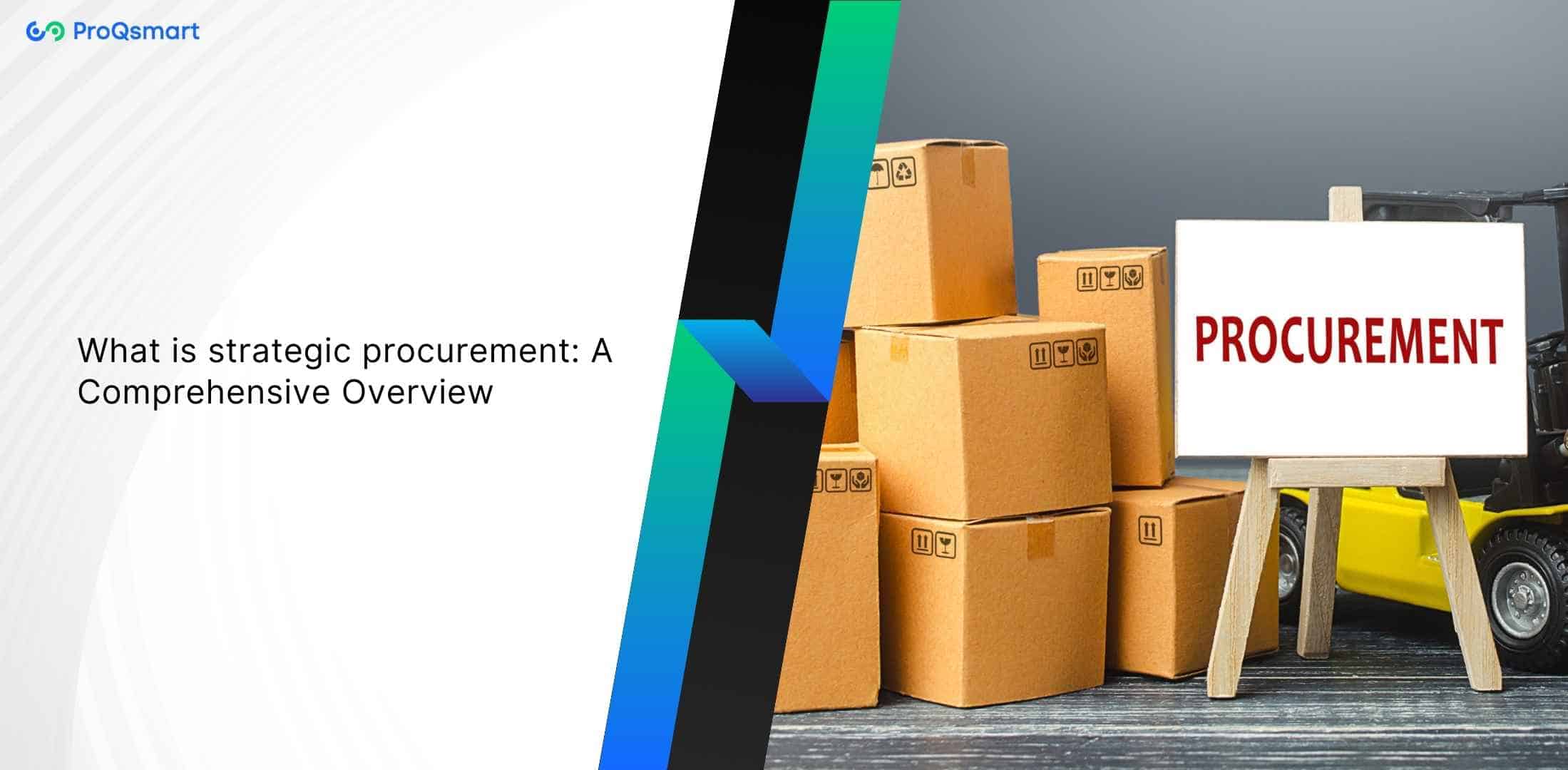Strategic procurement sounds fancy, right? It’s all about smart buying. It shapes the way companies spend cash. It’s not just shopping; it sets the stage for big wins.
Using key steps, it crafts deals that boost growth. You find it in tech, healthcare, and more. It’s got perks. It saves money, boosts quality, and cuts risks.
How? By getting the best deals and knowing the market. Technology plays a big role, too. Automated tools and data help make sharp decisions.
Ever heard of Amazon or Apple? They use strategic procurement to lead. It’s not just a skill. It’s a game-changer.
Dive into this post. Learn the ropes. Get ahead. Make procurement your secret weapon. Let’s shake things up!
Key Takeaways
- Strategic procurement is also crucial for ensuring long-term business success. It is about ensuring planning over and procuring activities, aligning it to the strategy of the overall firm.
- It impacts core goals such as reducing costs and managing risk. It also emphasizes supplier relationships and continuous improvement, both of which are essential to the success of any organization.
- The strategic procurement process begins with analyzing needs and planning effective procurement strategies. It then goes into choosing suppliers and handling their performance, which reduces inefficiencies and optimizes supply chains.
- Principles of strategic procurement, such as collaboration and transparency, sustainability, and value creation, can help form more effective partnerships and innovative procurement solutions.
- Utilizing technology such as e-procurement systems and data analytics significantly boosts the effectiveness of strategic procurement. It streamlines operations, improves decision-making, and enhances efficiency.
- Organizations face challenges like resistance to change and maintaining supplier relationships. They can still effectively carry out tactical procurement projects by incorporating rules such as collaboration and technology.
What Is Strategic Procurement?
Define Strategic Procurement
Strategic procurement is a comprehensive approach that aligns purchasing actions with the company’s overall business goals. It’s about more than just shopping; it’s smart planning to reduce costs and enhance what the company does. You know how sometimes you discover something wonderful at a store? That’s what a robust procurement strategy does for companies.
It also saves money by making informed choices around where and how they shop. It’s not solely focused on cash savings; it also involves identifying threats in the supply chain before they escalate into significant issues. If you know there’s a storm coming, you’re going to prepare, right? This strategic procurement plan allows businesses to foresee potential problems and prevent roadblocks effectively.
Another advantage is the way strategic procurement fosters strong relationships with suppliers. It’s similar to having that trusted barber who knows exactly how you like your haircut. When companies and suppliers collaborate closely, they both benefit. Plus, there’s ample opportunity for procurement innovation. With new technologies and modern practices, procurement can evolve into a faster, more efficient process rather than remaining sluggish.
Significance of Strategic Procurement
Strategic sourcing helps you navigate complex supply chains and streamline operations. Visualization is also used in sorting your expenses into buckets to determine where the money goes and focus on what matters. Companies do this by identifying spend categories.
Then, they create sourcing strategies that align with their objectives while ensuring they choose the most suitable suppliers. When it’s time to talk terms, strategic procurement is all about securing the best deals. You want to get a good price, but that’s not everything.
This is why building strong relationships with suppliers is so important; they will always come through. Keeping an eye on suppliers is crucial, too. Regular checks ensure they’re pulling their weight and identify areas for improvement. Firms with exceptional procurement skills experienced a staggering 42% higher return to shareholders. This trend was evident after the financial crisis. That’s how powerful strategic procurement can be.
Strategic Procurement Vs Operational Procurement
Strategic procurement isn’t just a back-office task. It’s a major player in providing competitive advantage for companies. It ties back to business objectives, ensuring that each purchase aligns with the company’s broader strategy.
While operational procurement concerns itself with daily purchases, strategic procurement casts its gaze beyond the daily grind of operations. It is about making data-driven smart decisions and aligning everyone involved. Communication and collaboration are key here, enhancing transparency and efficiency.
This approach prevents mistakes and unnecessary spending and guides the company to success.
Key Objectives of Strategic Procurement
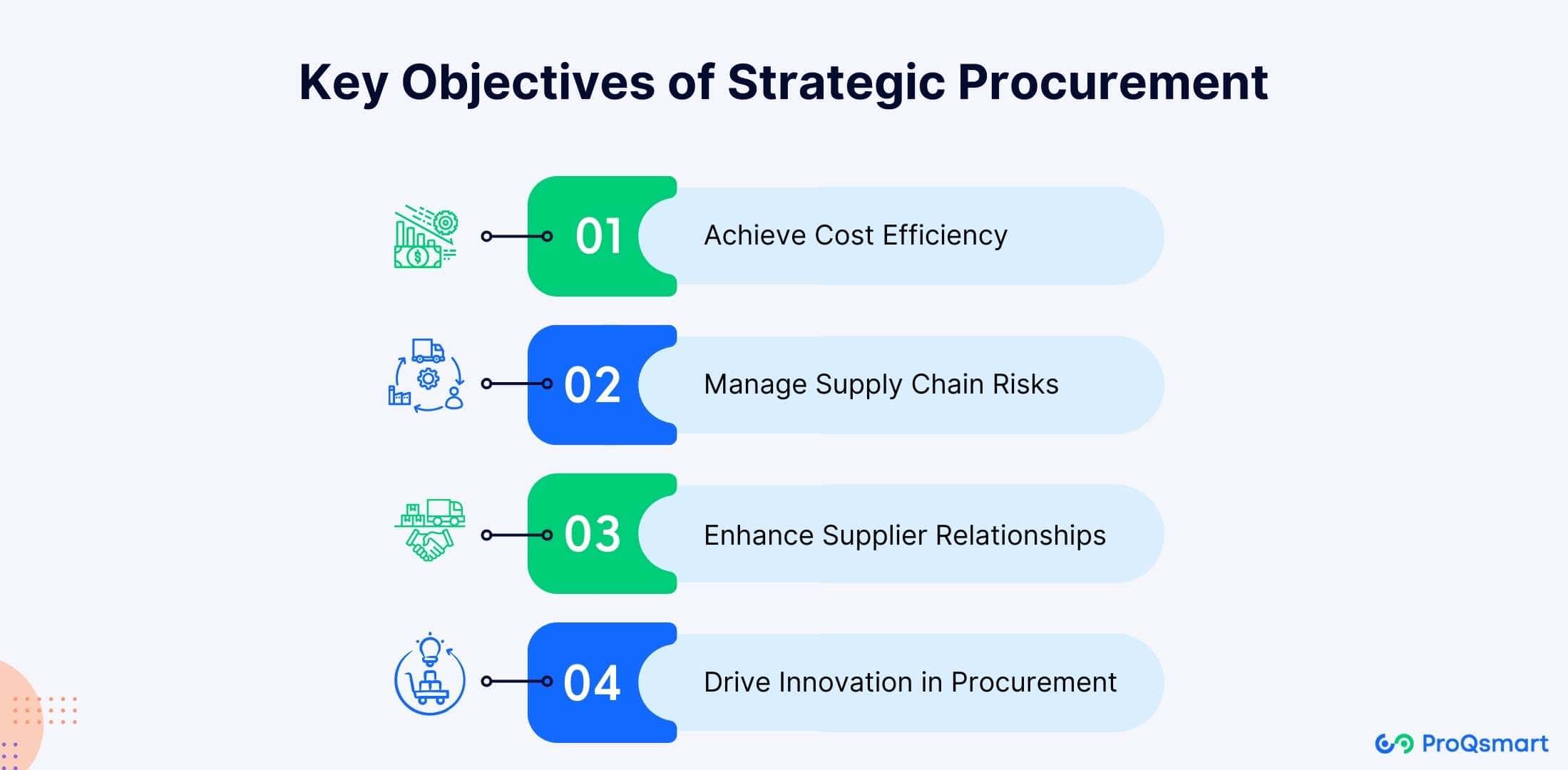
When we refer to the idea of strategic procurement processes, it’s all about smart choices that go beyond just cost savings. While cutting costs plays a significant role, it’s merely one piece of the puzzle. There are many other procurement strategies that can truly transform a company. Let’s break it down.
1. Achieve Cost Efficiency
Cost efficiency isn’t necessarily about penny-pinching. It’s about making smart choices and getting the most out of procurement. With digital tools, companies can accelerate purchasing like never before.
Think of AI-powered big data platforms that can cut sourcing time by over 90%. It’s more than just a time-saver; it increases accuracy, ensuring you purchase the items you intended for the best price.
Data analytics is super important in this context. It helps in making informed decisions by offering insights into spending patterns, supplier performance, and market trends. Automation is the name of the game here, minimizing manual work and enhancing productivity by streamlining workflows.
This way, you free up precious time and resources, allowing you to engage in much more useful strategic thinking and planning.
2. Manage Supply Chain Risks
Managing supply chain risks is critical in today’s volatile market. Companies must document clear procurement rules for consistency and compliance. This means establishing standards for all to use, which diminishes the ability to make mistakes or miss a focus.
Sustainability is also a big factor in risk management. By incorporating sustainable practices, companies not only align with customer demand for ethically sourced ingredients but also contribute to environmental stewardship.
This can range from choosing suppliers with green practices to opting for sustainable materials. It is also important to regularly review and refine procurement strategies based on performance metrics. This continuous improvement approach helps adapt to market changes and mitigate potential risks.
3. Enhance Supplier Relationships
Strong supplier relationships are akin to any partnership; they are built on trust and collaboration. To foster these relationships, companies need to overcome resistance to change, creating a culture of innovation and adaptability.
Investing in technology to enhance data collection and analysis capabilities is crucial. This will help overcome data limitations and provide a clearer picture of supplier performance.
Additionally, closing talent and skills gaps is important. Offering training and development opportunities ensures procurement professionals are well-equipped to handle challenges and foster strong supplier partnerships.
4. Drive Innovation in Procurement
Driving innovation through procurement can yield amazing results. Utilizing industry-specific case studies allows companies to showcase successful strategic procurement implementations.
These real-world examples provide templates for others looking to improve their own sourcing results. Innovative sourcing approaches, such as utilizing AI for supplier selection or implementing new negotiation strategies, can significantly impact outcomes.
These methods inspire connection, creativity, and invention. In turn, companies can launch over 100 new products successfully and increase R&D productivity by 60%.
Strategic Procurement Process
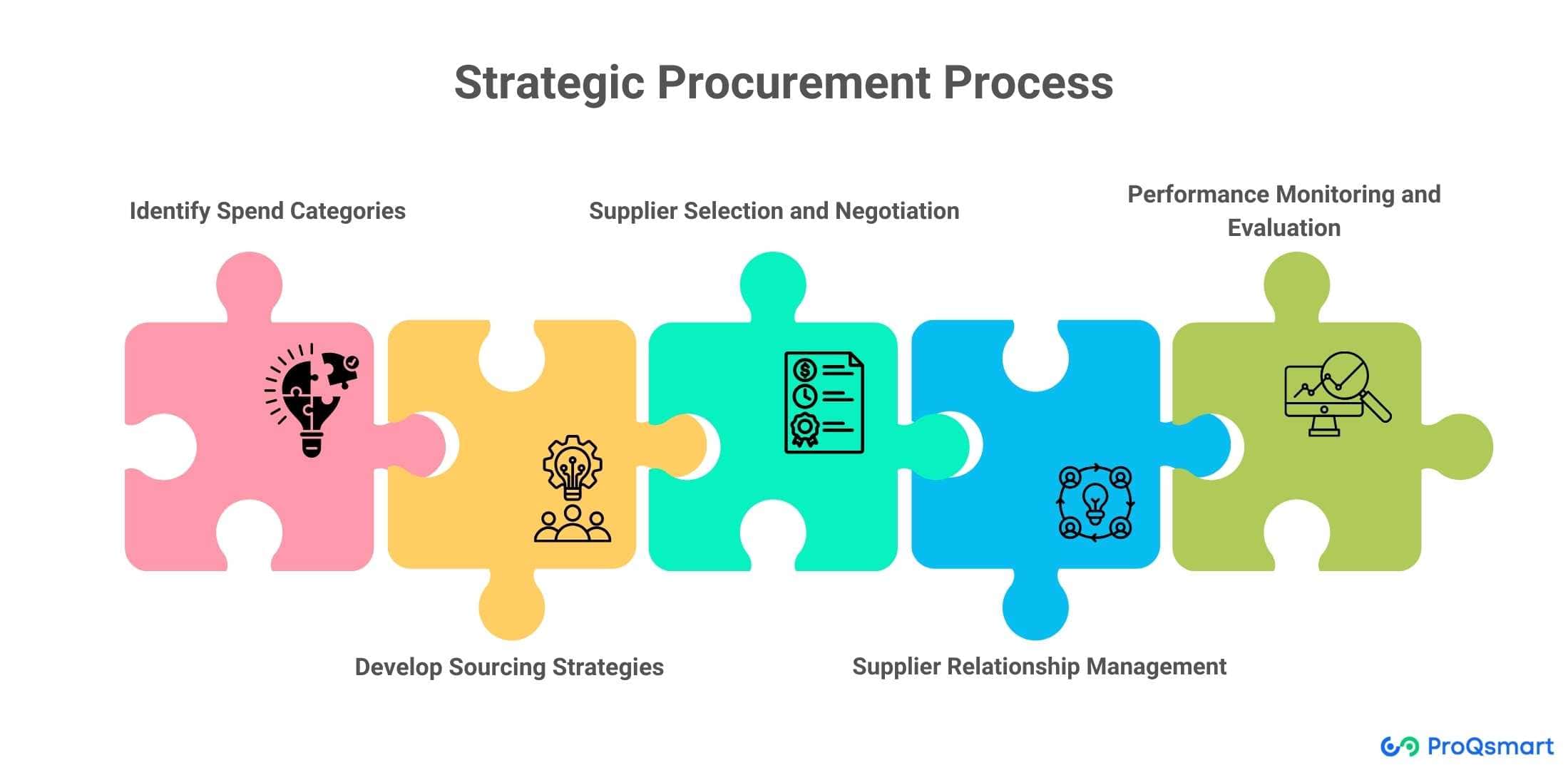
Strategic procurement isn’t merely a box to check off on the business to-do list — it’s a fundamental shift towards achieving strategic procurement objectives. It can redefine your financial status, boost efficiency, and bring results that matter. Companies today view procurement not as a back-office role but as a crucial weapon for competitive advantage through a solid procurement strategy.
The proof? Firms with world-class procurement strategies significantly outperformed their competitors. They created a remarkable 42% larger total return to shareholders, particularly evident after the 2008 global financial crisis.
Okay, enough about the person; let’s talk tech. This means embracing strategic procurement technology and advanced technologies that supercharge your procurement game. Stuff like AI and blockchain can make processes more streamlined and more transparent.
This isn’t simply about following the Joneses; this is about redefining the Joneses. For example, using AI for predictive analytics helps you see demand changes in advance, so you’re never taken by surprise.
Equally important is working in sustainable and ethical ways. Consumers today expect responsible sourcing and procurement. By prioritizing eco-friendly suppliers, you build trust and loyalty.
If you pick companies that respect labor, you’re actually making a contribution and not just checking a box. Partnering with suppliers that use renewable energy can lower your carbon footprint significantly. This move corresponds neatly with global sustainability aims.
Identify Spend Categories
The first thing you should do is identify what categories of goods and services gobble up most of your organization’s budget. This isn’t a quick scan — it’s a deep dive.
To align procurement with business needs, it’s important to know where your money goes. It’s like knowing which ingredients take up most of your recipe, so you’re stocked up where it matters most.
Develop Sourcing Strategies
Once you understand your spend categories, you can begin to develop sourcing strategies. You have this very careful, systematic approach.
Align these strategies with overall business goals. It’s like programming in the GPS before a long road trip. Each strategy has to be personalized so you’re not wasting money but adding value.
Supplier Selection and Negotiation
Choosing and negotiating with suppliers is where the numbers break down, and relationships become important. It’s crucial to know a supplier’s capabilities.
This is not a one-size-fits-all scenario. Every negotiation should build a partnership. These discussions should be guided by key performance indicators (KPIs) such as price, delivery, and quality to make sure you’re aligned.
Supplier Relationship Management
Supplier relationship management is more than a handshake; it’s an ongoing process. Fostering and nurturing these connections is key.
Regular check-ins and feedback loops help you understand their capabilities. It’s like tending to a garden; over time, putting in the work reaps the greatest rewards.
Performance Monitoring and Evaluation
Finally, watch the performance. Assess suppliers using KPIs over time. This isn’t nitpicking; it’s making sure you both grow.
Regular assessments indicate when to adjust strategies and improve efficiencies. Remember, what’s measured improves.
Principles of Strategic Procurement
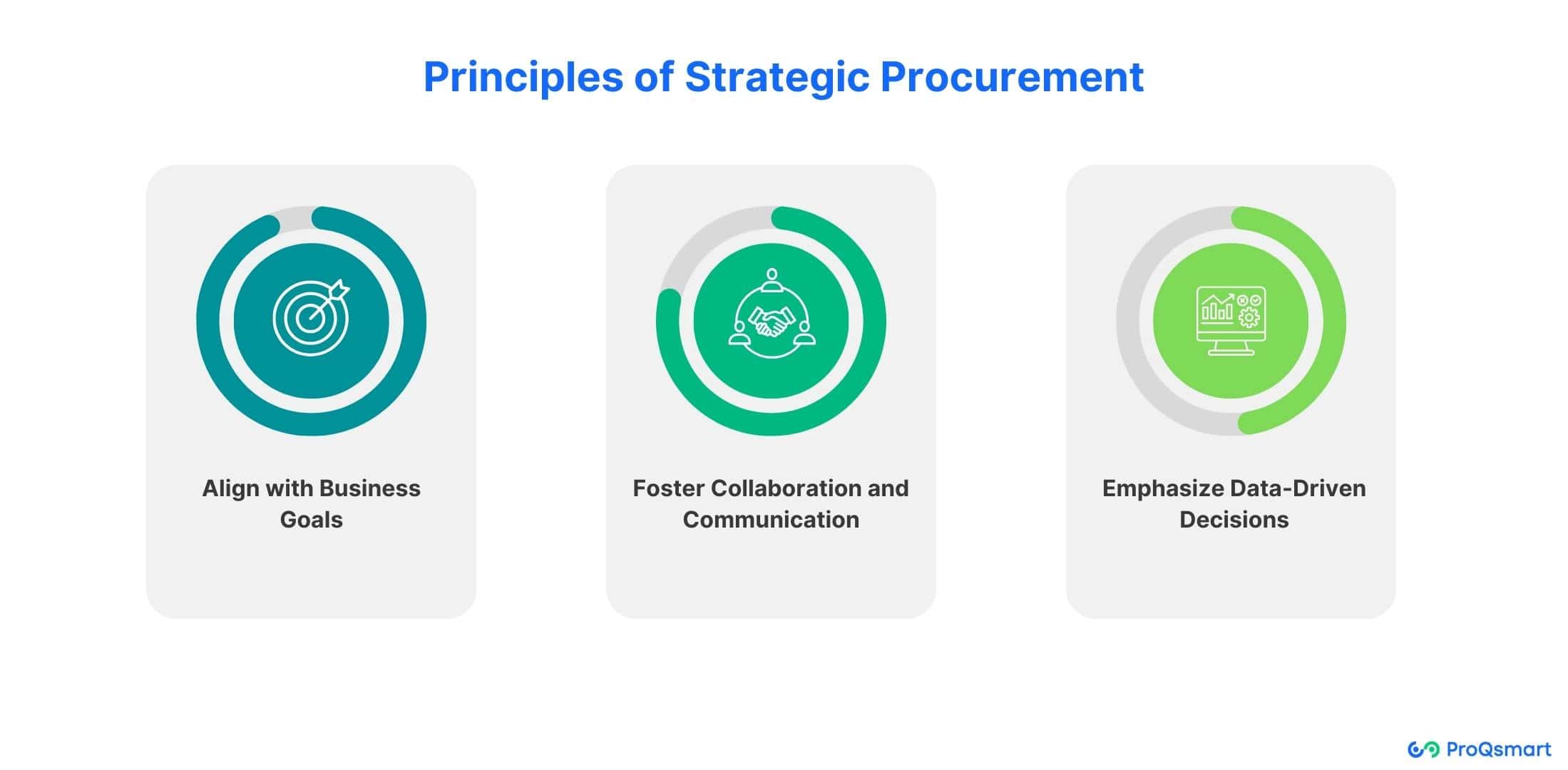
Align with Business Goals
Strategic procurement is about aligning what you’re purchasing with what the business wants to accomplish. It’s not just about finding the cheapest option; it’s about viewing the whole picture. A good strategy essentially takes a long view and actively engages all stakeholders, inside and outside the company.
P&G actively employs strategic sourcing principles like Best Total Value. This strategy means considering more than just the purchase price to reduce it personally. This approach not only saves businesses money but also allows them to confirm quality and service.
Aligning procurement strategies with business objectives ensures that procurement contributes directly to the organization’s overall competitiveness and growth.
Foster Collaboration and Communication
Strong relationships with suppliers and stakeholders are key in strategic procurement. It’s about collaboration and keeping those lines of communication open. P&G focuses on maintaining stable relationships with suppliers that provide value consistently.
They connect the supply solutions with external parties, enabling them to leverage market intelligence and a global network of suppliers to identify solutions that meet their specific needs. The difference between strategic sourcing and category management becomes clear here: while both focus on procurement, strategic sourcing involves a comprehensive methodology that ensures all stakeholders are on the same page.
This collaboration results in improved outcomes and innovations, keeping the business competitive.
Emphasize Data-Driven Decisions
Data is the backbone of strategic procurement. Relying on data to inform decisions allows organizations to find the most effective opportunities to reduce costs and increase quality. Tom Beaty with Insight Sourcing Group highlights how strategic sourcing is both a science and an art.
It digs into data, trying to find every opportunity to save and improve. By 2025, nearly 80% of procurement organizations are projected to adopt digital procurement platforms as we head to that date. This shift shows just how important technology is for data-driven decision-making.
It streamlines processes, cuts down rogue spending, and increases effectiveness. By concentrating on data, businesses can fine-tune their procurement strategies and make more intelligent, well-informed decisions.
Benefits of Strategic Procurement
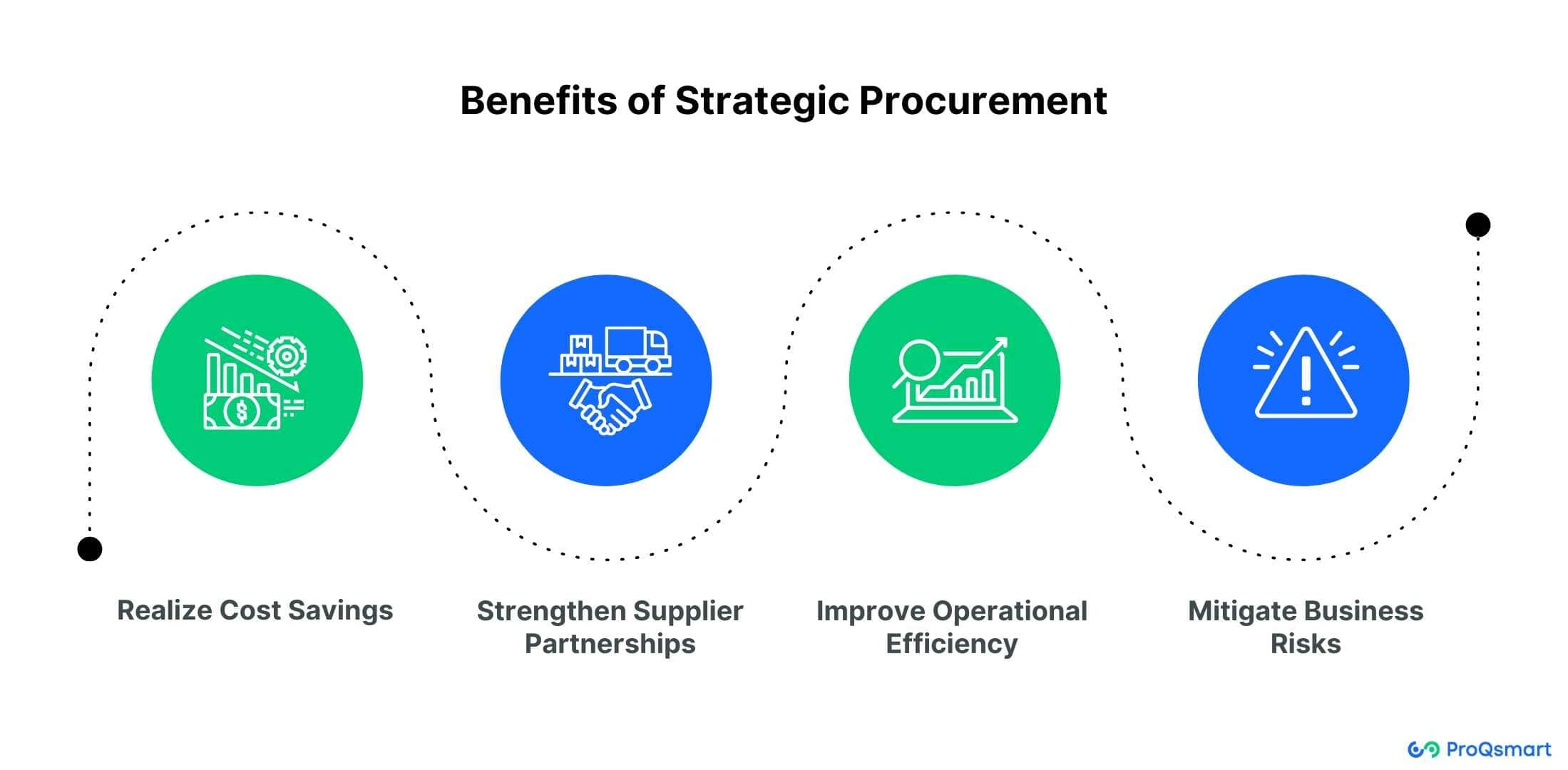
Realize Cost Savings
Strategic procurement is all about getting bang for your buck. It’s not about the cheapest ticket; it’s about smart buying. For example, utilizing economies of scale can lead to substantial savings. Imagine taking $30,000 in cuts from office supplies simply by consolidating where you buy them.
That’s actual money you can reinvest in your business. It’s also about opting for energy-efficient products, which not only save you money but also help save the planet. Minimizing waste and using your purchasing power wisely can make a huge difference in your budget.
When done right, strategic procurement is a win-win for your wallet and the world.
Strengthen Supplier Partnerships
Developing great relationships with suppliers is essential for an effective procurement strategy. By establishing clear performance metrics and feedback loops, you can enhance your strategic procurement processes and collaborate more effectively with suppliers to achieve better results. This teamwork can produce faster innovation and significant cost savings.
Companies that foster strong supplier management tend to gain efficiencies and see new ideas emerge. It’s akin to having a trusted partner that helps you reach your strategic procurement objectives more quickly.
During the 2008 financial crisis, companies that embraced a robust procurement strategy recovered faster, outperforming others by 42%. This illustrates the power of strong supplier ties in achieving overall business goals.
Improve Operational Efficiency
Strategic procurement isn’t so much about what you buy — it’s about how you buy it. By eliminating administrative work, you save time and money. This means your team can focus on what you really need them to do, which in turn increases productivity.
Using technology and data tools can cut sourcing time by 90% or more. That’s a HUGE time saver! With less time spent on paperwork, you can simplify operations and spend more time growing your business.
This approach keeps everything moving, ensuring that your business stays intact.
Mitigate Business Risks
In times of crisis, smart sourcing is a lifeline. It helps businesses remain competitive without just focusing on price. When you embrace green alternatives and make smart product choices, you eliminate risk and maintain your lead.
This minimizes vulnerabilities and guarantees operational stability. You’re not just getting by; you’re getting ahead, even when times are tough.
It’s about being proactive, staying ahead of the curve, and preparing for whatever challenges come your way.
Role of Technology in Strategic Procurement
Digital Tools for Procurement Efficiency
Let’s get into these digital tools, which are so transformative for strategic procurement. We’re talking stuff like ProcureTech, which is a fancy word for procure technology. This is up to but not limited to cool innovations like AI, blockchain, and IoT.
These tools enable companies to optimize their procurement processes and make them more seamless and quicker, eliminating frustrating manual errors. For example, AI isn’t just a buzzword here. It’s actually doing things like spend analysis and managing contracts, which saves a ton of time.
It’s like you have this super-smart assistant that just makes sure everything stays on track.
Enhancing Data Analytics in Procurement
Data is gold in procurement, and technology is the pickaxe to dig up that gold. The right tools allow companies to collect data from many sources. Then, they can analyze this information and extract meaningful insights into their procurement processes.
This is not only about numbers; it’s about recognizing patterns and making smart decisions. For example, you can monitor spending habits or supplier performance, enabling you to refine your strategy.
In fact, the procurement software market is soaring. It’s expected to almost triple, growing from $6.67 billion in 2022 to $17.90 billion by 2032. There’s no mistaking it: embracing these tools is no longer optional.
Automation and Workflow Optimization
I would say that automation is like magic in procurement. It streamlines processes and reduces errors from manual data entry. Imagine if you had a system that automatically took care of your financial processes, making fewer mistakes and allowing you to plan your finances more wisely.
It’s what we like to call having your cake and eating it too. Companies are utilizing automation to streamline workflows, making everything run more efficiently.
While searches for “e-procurement” have dropped globally by 23% recently, this doesn’t suggest tech’s influence is waning. It’s more about becoming smarter solutions.
Automation keeps everyone on the same page, so there’s less chaos. It puts in place a more orderly procurement process.
Best Practices for Strategic Procurement
Establish Clear Guidelines
When it comes to strategic procurement, setting clear guidelines lays down the roadmap. You want to outline how your organization will strategically handle procurement activities. Develop a holistic strategy that communicates your priorities.
Focus on supplier relationship management; it is essential for maximizing your potential. With these clear guidelines, you can ensure that every decision you make supports your business’s goals. For example, the 80/20 rule applies when awarding contracts to several suppliers, maintaining flexibility and risk mitigation.
This method not only diversifies your supply chain but also enables better negotiations and potential cost savings. With some spend, negotiating discounts with primary suppliers can move the needle substantially when it comes to your bottom line.
Integrate Sustainable Practices
Sustainability is no longer a buzzword — it’s a requirement. Tying sustainable practices into your procurement processes can help pay off in the long run. It’s not just about selecting sustainable items but also sourcing from suppliers that align with those values.
Managing supplier relationships becomes key here. Make sure your suppliers meet your business needs perfectly. You also need to ensure that they’re in line with your sustainability pledge.
An example might be choosing suppliers with certifications for environmental sustainability. This not only boosts your brand image but also helps you stay ahead of regulations that are becoming more focused on sustainability.
Continuously Improve Procurement Processes
In the digital age, continual improvement is crucial. Using technology can simplify procurement and make it more efficient while reducing mistakes. AI-powered big data can reduce sourcing time by more than 90%, and that changes everything.
These platforms have advanced search and analytics functions that support data-driven decision-making. Data analytics becomes incredibly important here, as both internal and external data provide insight that helps you craft your strategy.
By analyzing and optimizing your procurement processes continuously, you keep yourself ahead of the curve, adjusting to changes in the market quickly. Regularly revisiting your strategy ensures that you’re not just reacting to changes but proactively enhancing your procurement operations.
Challenges in Implementing Strategic Procurement
Implementing strategic procurement objectives isn’t about changing what we buy or who we buy it from; it’s about altering the way we think about purchasing altogether. This shift can get tricky because people often resist change. Many of us are big fans of sticking to what we know, even if the new approach promises better outcomes.
Within procurement teams, this resistance can be a significant hurdle. However, even though 81% of leaders recognize the need for a solid procurement strategy, few take action. To overcome this challenge, it’s essential to get everyone on board early in the process. Demonstrating the value through quick wins and sharing case studies from similar companies can ease the fear of the unknown while building a sense of ownership and trust.
Data Limitations
Another big challenge is addressing data limitations. Digital transformation is top of the priority list for 76% of procurement leaders. I’m troubled that only 32% have activated their digital strategies. Why is that the case? Well, without the right data, it’s like driving blindfolded.
Making informed purchasing decisions is impossible without a comprehensive view of the situation. Data gaps can lead to poor visibility, adversely impacting cash flow and cost savings. For instance, improved transparency might enhance savings by as much as 20%. To tackle this issue, invest in strategic procurement technology that not only captures data but also facilitates sharing across the organization.
This destroys silos, enabling procurement teams to align with company-wide strategies and forecast future needs. Then there’s the issue of talent and skill gaps. The role of procurement has evolved since the 2000s, and professionals are tasked with managing more strategic concerns.
Cost of Materials
The cost of materials has been skyrocketing due to global occurrences, creating a perfect storm for procurement risks. In fact, 70% of Chief Procurement Officers (CPOs) have seen this trend. Bridging these skill gaps can make all the difference. Encourage ongoing education and training initiatives that emphasize strategic thinking and how to leverage technology.
Partner with educational institutions or develop in-house training programs to upskill your team. That way, they have the tools and confidence to create strategies that drive the business’s bottom line.
Examples of Strategic Procurement Strategies
Industry-Specific Case Studies
The power of strategic procurement is best illustrated in real life. Take Coca-Cola, for example. Their procurement strategy isn’t only about getting the best deals; it’s about embracing supplier diversity. By working with a variety of suppliers, Coca-Cola increases innovation and connects better with various markets around the world.
They aim to get half of their key suppliers involved in programs that support corrective actions every year. This effort shows how serious they are about continuous improvement and innovation.
Now, let’s take a look at BMW. Their strategy places an emphasis on transparency, particularly in supply chains. This transparency is critical for sustainable raw material extraction, which in turn supports a circular economy. BMW is upfront about its processes, allowing them to serve today’s demands while protecting resources for tomorrow.
This is a great example of how strategic procurement can complement sustainability aims.
Unilever offers another interesting case study with their Responsible Partner Policy. This policy sets high expectations for suppliers, focusing on sustainability, human rights, and fair treatment. This proactive approach ensures that not only is their supply chain efficient, but it’s also ethical.
Unilever deploys the latest technology to increase visibility in its supply chains, enabling more intelligent data-driven decisions.
Innovative Sourcing Approaches
Innovation in sourcing is a game changer. For example, Walmart’s procurement strategy is deeply rooted in the vision outlined by founder Sam Walton: to offer low prices and great value. They achieve this by ensuring their supply chain is efficient and inexpensive.
Walmart’s approach stands as a testament to how smart procurement can connect directly to a company’s vision and mission.
Coca-Cola is also experiencing success with its innovative sourcing. By focusing on innovation in procurement, they expand the limits of what is possible and define new possibilities. They encourage major suppliers to join them in corrective action plans and capability-building exercises, creating a cycle of ongoing improvement.
Companies such as Johnson & Johnson emphasize the need to differentiate between strategic and operational procurement. They effectively manage both aspects and have become a model for procurement excellence.
This demonstrates that a combination of depth and breadth in procurement strategies can lead to great success.
Future Trends in Strategic Procurement
Embrace Digital Transformation
In the world of Smart Procurement, digital is beginning to upend the entire game. The 2024 procurement landscape is changing radically. By 2025, we expect strong 14% CAGR in spend on E-Sourcing platforms.
What’s behind this shift? It’s really getting smart with tech. By 2025, half of the major global companies will adopt AI, advanced analytics, and IoT, experts predict. These technologies will revolutionize their supply chains. This tech isn’t just about making things faster—it’s about making them better.
One example might be using AI to predict market volatility or advanced analytics for measuring procurement success. It’s like having a miracle ahead of time’s crystal ball, making decisions that cost less and innovate more.
Take, for example, a food business automating its tail-end negotiations. They found that while automation is necessary, precise and reliable data on suppliers is essential. It’s not necessarily tech for its sake; it’s about using it to add true value.
For a CPO at a manufacturing firm, procurement has made its way to the top of the priority list. This shift demonstrates the importance of digital tools in the industry today.
Focus on Sustainability and Ethics
Sustainability and ethics are front and center in procurement strategies now. By 2025, 80% of companies will base their procurement decisions on ESG (Environmental, Social, and Governance) principles. This change represents a pivot in how companies view sourcing and sustainability.
It’s not just a fad; it’s becoming the standard. Part of this shift is a demand for transparency and the need to build trust with stakeholders. For example, a chemical company’s CPO noted the dangers of not connecting price adjustment plans to procurement strategies. Not doing so can hurt the margins and erode that trust.
Integrating ESG factors is not only about being green; it’s about building long-term value. One CPO at a leading pharma company said they feel unprecedented volatility in the market, which makes sustainable practices even more critical.
It’s just about being prepared for what the market throws at you. In 2025, procurement success won’t just be about cutting costs; it’s going to be about driving innovation, driving sustainability, and driving value for the long term.
Conclusion
Strategic procurement sounds like a big deal, and it is. It’s all about smart ways to buy stuff that kick up your business. We’ve discussed what makes it tick, from the basics to the benefits. Technology plays a big role, too. Without it, you miss out on speed and accuracy. We’ve included tons of examples and future trends so you know what to expect.
Incorporating smart procurement in your operations can provide you with a true advantage. You get better deals, save money, and improve processes. It’s your own game plan to win in the marketplace.
Ready to dive deeper into strategic procurement? Give our guides a try. They provide you with step-by-step directions to get you started. Now get to work and see your business take off.
FAQs
What is strategic procurement?
Strategic procurement is the process of planning, sourcing, and acquiring goods and services to meet an organization’s long-term goals. It’s all about creating value, saving costs, or getting better suppliers.
Why is strategic procurement important?
Strategic procurement processes are crucial to improve efficiency, lower costs, and foster supplier relationships while aligning procurement strategies with overall business goals.
How does technology aid in strategic procurement?
Technology streamlines strategic procurement processes by optimizing communication with suppliers and automating repetitive tasks. Tools such as AI and blockchain enhance procurement analytics, ensuring transparency and efficiency.
What are the key objectives of strategic procurement?
The main objectives of an effective procurement strategy include cost reductions, risk management, quality improvements, and enhancing supplier relationships, aligning procurement with overall business goals.

